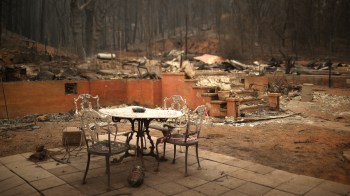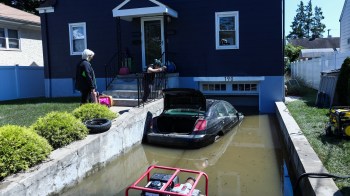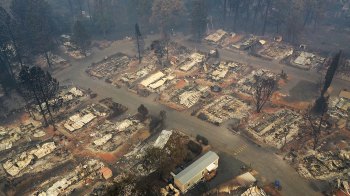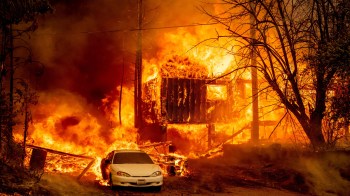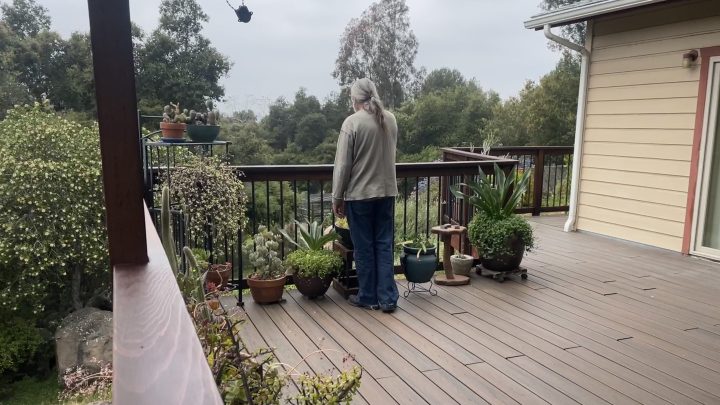
Safety net home insurance plans are becoming the only option for many in disaster-prone states
Safety net home insurance plans are becoming the only option for many in disaster-prone states

Paul Felber’s two-acre property in East San Diego County is lush and green after this year’s winter rainstorms.
The 72-year-old retiree doesn’t just maintain his yard. He’s trying to transform it.
“What I really wanted to focus on was trying to restore, as much as possible, a native plant community on this property,” he said.
There’s a certain zen ritual to it all. Yank out the non-native mustard and star thistle plants. Nurture the budding Penstemons and California lilacs.
And according to Felber, that’s not the only challenge with his property.
“I live in a high fire risk — in fact, I live in an extreme high fire risk area,” he said.
Felber and his wife have cut back much of the flammable vegetation bordering their home and spent more than $60,000 to harden it against wildfire. But home insurance companies weren’t impressed. In the last five years, the Felbers were dropped by two different companies.
“Nobody else was available to insure our property,” he said. “So I ended up on the California FAIR Plan.”
Their annual premium over the last several years increased from about $1,500 to $5,500.
It’s a familiar story in places threatened by climate-fueled disasters. Private insurance companies are retreating, leaving safety net insurance plans — often called “FAIR Plans” — to fill the gap.
In Florida and North Carolina, these last-resort plans have ballooned in recent years due to increasingly devastating storms and hurricanes. In California, where wildfires are getting more extreme, the number of FAIR Plan policies has tripled since 2018 to more than 375,000.
“It’s been a tremendous increase in a very short period of time,” said Victoria Roach, president of California’s FAIR Plan, during a state Assembly hearing in March. Roach declined multiple interview requests.
“There’s not a lot of options out there for people,” she said at the hearing. “And so, instead, the FAIR Plan is quickly moving to be the first resort for a lot of people.”
California’s FAIR Plan is a state-mandated insurance pool run by private insurance providers that do business in the state. But it’s costly for homeowners and doesn’t provide comprehensive coverage. So the idea has always been to move people back into the traditional insurance market as quickly as possible.
Still, these days, many homeowners find themselves stuck on the safety net plan for years.
“The growing FAIR Plan is really what keeps me up at night,” said California Insurance Commissioner Ricardo Lara. “It puts the highest risk properties into one pool.”
That means a bad wildfire season could destroy many homes on the FAIR Plan, triggering an avalanche of costly payouts. And that could drain the plan’s financial reserves.
Lara said this scenario would further destabilize the state’s insurance market.
“Getting people off the FAIR Plan and back into a competitive market is one of my top goals,” he said.
Lara has proposed a plan that would require insurance companies to write more policies in fire-prone areas. Though there’s a tradeoff — the state would make it easier for those companies to raise rates.
Lara believes the reforms will bring more competition and predictability to California’s shaky insurance market.
But Felber, the retiree outside of San Diego, said he’ll believe the change when he sees it.
“It leaves me hanging out in the wind while, from my perspective, corporate America and government try to come to some agreement,” he said. “Which usually, in my experience, takes a long time.”
While he waits, Felber’s yard will keep him plenty busy. After all, the invasive cat’s ear plants this year have been especially stubborn.
There’s a lot happening in the world. Through it all, Marketplace is here for you.
You rely on Marketplace to break down the world’s events and tell you how it affects you in a fact-based, approachable way. We rely on your financial support to keep making that possible.
Your donation today powers the independent journalism that you rely on. For just $5/month, you can help sustain Marketplace so we can keep reporting on the things that matter to you.


